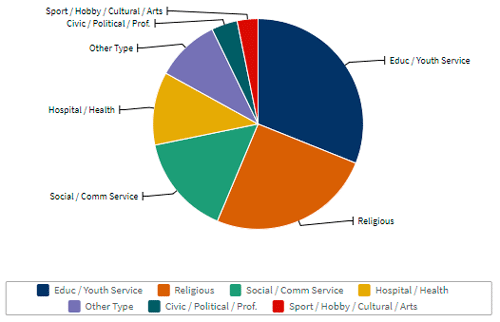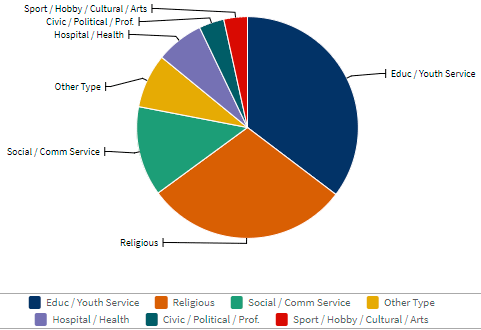Youth who receive special education services under the Individuals with Disabilities Education Act (IDEA 2004) and especially young adults of transition age, should be involved in planning for life after high school as early as possible and no later than age 16. Transition services should stem from the individual youth’s needs and strengths, ensuring that planning takes into account his or her interests, preferences, and desires for the future.
Volunteerism
Rates
Volunteering and Civic Life in America, 2014 shows that 62.6 million Americans volunteered 7.7 billion hours in 2014 — holding an estimated value of $173 billion. Seventeen percent of respondents reported mentoring youth, and 19 percent reported tutoring or teaching young people.
Many of the nation’s volunteers are young people. Most youth volunteers do so out of altruism and an interest in making in a difference in the lives of others. Only a small proportion of students reportedly volunteer because of a school requirement.[1]
In 2015, CNCS found that a quarter of college students (3 million) volunteered 286 million hours of service, worth $6.7 billion.[2] Figure 1 shows the breakdown of college student volunteerism.[3]
FIGURE 1: COLLEGE STUDENT VOLUNTEERISM
Additionally more than a quarter of teenagers (4.3 million) volunteered 345 million hours of service, worth $8.1 billion.[4] Figure 2 shows the breakdown of teenager volunteerism.[5]
FIGURE 2: TEENAGER VOLUNTEERISM
Benefits for Youth
- Youth who volunteer are more likely to feel connected to their communities and, do better in school, and are less likely to engage in risky behavior.[6]
- Youth are not only more likely to volunteer if their entire family is involved in the effort, but the shared experience can result in strengthened familial bonds.[7]
- According to a study, students who performed voluntary community service were 19 percent more likely to graduate from college than those who did not.[8]
- Another study found that volunteering was associated with a 27 percent higher odds of employment.[9] Download an infographic on volunteering as a pathway to employment (PDF, 1 page).[10]
- According to Troppe and Michel[11], volunteering while young provides lasting effects, including:
- Two-thirds of the 44 percent of adults who volunteered began volunteering while they were young.
- Adults who volunteered at a young age, regardless of income, donate to and volunteer more at charitable organizations than adults who did not volunteer.
Best Practices
Best Practices for Recruitment
Sometimes the best way to get youth to volunteer is simple: ask. According to one study, young people who are asked to volunteer or vote are much more likely to do so.[12] AmeriCorps (formerly the Corporation for National and Community Service) found that “youth volunteers who have a positive experience are likely to volunteer again and tell their friends about it. Those friends, in turn, will be more inclined to volunteer.”[13]
Youth who are at-risk or from diverse backgrounds
According to research, youth from disadvantaged backgrounds are less like than their upper- and middle-class peers to volunteer. AmeriCorps suggests that 43 percent of disadvantaged youth reported volunteering, compared to 59 percent for all American youth.[14]
In addition, only ten percent of disadvantaged youth believe that they can make "a great deal of difference in their community" and 41 percent reported that they had "a little, almost none, or no difference at all.”[15]
Similarly, students with lower academic achievement are not volunteering at the same rate as those reporting higher academic achievement. Of students who reported having a B+ average or above, 46 percent responded that they have been involved in volunteering as a part of school compared to 26 percent of those students who reported having a C average or lower.
AmeriCorps emphasizes the importance of recruiting youth from diverse backgrounds and experiences, who are not traditionally involved or asked to serve in volunteer efforts.[17] To ensure that youth from diverse backgrounds feel welcomed, it is necessary to be sensitive and conscious in multicultural and diversity efforts. AmeriCorps suggests the following three strategies:[16]
- Establish name recognition for your program within the targeted community.
- Develop an articulated, well-conceived plan.
- Collaborate with existing programs (such as after-school clubs, music groups, and sports teams) that bring in youth from your target population and have name recognition in the community.
Including family members
According to a 2005 survey, when compared to a youth with no family members who volunteer, a youth from a family where at least one parent volunteers is almost twice as likely to volunteer, and nearly three times more likely to volunteer on a regular basis.[18]
Many family members have not been invited to volunteer, and may not understand the potential benefits to all members of the family. Extending a personal invitation and underscoring what volunteers have to gain—job skills, community connections, academic credit—can make a difference.[19] Even if family members are unable to volunteer or choose not to, organizations can foster a sense of partnership and help the families to feel comfortable with the program their child is participating in by providing informational materials, inviting them to an orientation session, hosting family events, providing wrap around services, and recognizing families at special events.[20]
Best Practices for Engagement
Organizations hoping to involve youth need to think about their goals and the tasks they want to accomplish, and about whether youth can fulfill the roles necessary to accomplish them. Troppe and Michel[21] suggest that “focusing on the skills needed rather than the age of the potential volunteer is a critical first step toward changing an organization’s mindset about who can get a job done” (p. 17) and that “with that in mind, it is critical for agencies to think outside conventional boundaries and open up multiple opportunities and roles for young people.” (p. 18)
Regardless of the community, effective practices for engaging youth include the following:
- Provide meaningful service that directly relates to community or youth needs.
- Teach critical skills, including
- providing training;
- providing careful supervision,
- addressing problem solving, leadership, teamwork and life skills; and incorporating service-learning.
- Create youth-adult collaborations.
- View youth as a resource.
- Celebrate success and recognize youth.[22]
Youth can provide added energy, ideas, and value to organizations through youth volunteering efforts, but there can be substantial barriers to the success of youth engagement. Troppe and Michel[23] highlight ways that organizations can address issues and barriers during the initial stages of youth involvement in service, based on their review of successful youth volunteering organizations. These include the following strategies:
- Provide adults with advice about how to work with youth, and youth advice about how to work with adults.
- Openly discuss stereotypes that youth may have about adults, and that adults may have about youth.
- Practice “shared power” (i.e., shared responsibility for activities).
- Establish clearly defined roles and responsibilities for adults and youth.
- Establish clear decision-making processes that ensure youth are included in meaningful ways.
- Pay careful attention to logistical issues that may affect youth participation, including lack of transportation and conflicts with school and work schedules. Incentives—even simple ones, like food—can also make a difference.
Resources
Serve.gov
This website from AmeriCorps aims to expand the impact of existing organizations by engaging new volunteers in their work and encourage volunteers to develop their own "do-it-yourself" projects. The website provides opportunities to sign up for service projects across the country and toolkits for creating local projects that meet community needs.
References
1 AmeriCorps, 2005
2 AmeriCorps, n.d.a
3 https://data.nationalservice.gov/National-Service/College-Students-Main-...
4 AmeriCorps, n.d.b
5 https://data.nationalservice.gov/National-Service/Teenagers-Main-Organiz...
6 AmeriCorps, 2005
7 AmeriCorps. Presidential Council on Service and Civic Participation, 2010b
8 Dávila & Mora, 2007
9 AmeriCorps, 2013
10 https://www.nationalservice.gov/sites/default/files/evidenceexchange/FR_... (PDF, 1 page)
11 Troppe & Michel, 2002
12 Lopez, Levine, Both, Kiesa, Kirby, & Marcelo, 2006
13 AmeriCorps. Presidential Council on Service and Civic Participation, 2010c
14 Spring, Dietz, & Grimm, 2007
15 AmeriCorps. Presidential Council on Service and Civic Participation, 2010d
16 AmeriCorps, 2005
17 AmeriCorps. Presidential Council on Service and Civic Participation, 2010d8
18 AmeriCorps, 2005
19 AmeriCorps. Presidential Council on Service and Civic Participation, 2010c
20 AmeriCorps. Presidential Council on Service and Civic Participation, 2010b
21 Troppe & Michel, 2002
22 Hathi & Bhaerman, n.d.
23 Troppe & Michel, 2002
Other Resources on this Topic
Agencies
Announcements
Collaboration Profiles
Feature Articles
Internships
Programs
Publications
Resources
Technical Assistance
Tools & Guides
Websites
Youth Topics
Youth Briefs
Research links early leadership with increased self-efficacy and suggests that leadership can help youth to develop decision making and interpersonal skills that support successes in the workforce and adulthood. In addition, young leaders tend to be more involved in their communities, and have lower dropout rates than their peers. Youth leaders also show considerable benefits for their communities, providing valuable insight into the needs and interests of young people
Statistics reflecting the number of youth suffering from mental health, substance abuse, and co-occurring disorders highlight the necessity for schools, families, support staff, and communities to work together to develop targeted, coordinated, and comprehensive transition plans for young people with a history of mental health needs and/or substance abuse.
Nearly 30,000 youth aged out of foster care in Fiscal Year 2009, which represents nine percent of the young people involved in the foster care system that year. This transition can be challenging for youth, especially youth who have grown up in the child welfare system.
Research has demonstrated that as many as one in five children/youth have a diagnosable mental health disorder. Read about how coordination between public service agencies can improve treatment for these youth.
Civic engagement has the potential to empower young adults, increase their self-determination, and give them the skills and self-confidence they need to enter the workforce. Read about one youth’s experience in AmeriCorps National Civilian Community Corps (NCCC).








